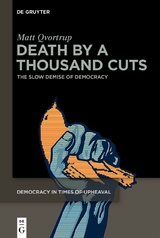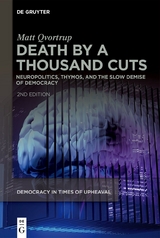Death by a Thousand Cuts
De Gruyter (Verlag)
978-3-11-069817-6 (ISBN)
- Titel erscheint in neuer Auflage
- Artikel merken
Mehran Mousapoor, Persian Gulf Bid Boland Gas Refinery, Teheran, Iran.
lt;p>Chapter 1: A Short History Years of Democracide
How Democracies die by stealth
Democracies do not die overnight. The process is gradual, and the system is rarely dismantled officially. There are still presidential elections in Russia, Turkey and Venezuela today - just as there were elections in the authoritarian states of Japan and Poland in the 1930s. They just mean - or meant - very little. The results of elections in authoritarian states are a foregone conclusion. This has been the pattern throughout the history, Chapter One chronicles how democracies have been dismantled by stealth. It documents how history echoes and rhymes; and how present-day authoritarians successfully employ the techniques used a century ago - and even before. But the chapter also details how the new generation of demagogues have invented a whole new science of democratic destruction; how new technology is making democracies even more vulnerable than in earlier periods of history
Chapter 2: Scapegoating and Spin
How Demagogues Win Power
The history of elections is the history of 'spin'. Where there are elections, there are politicians who are willing to use 'alternative facts' in pursuit of power. In good times, these are exposed by a vigilant and free press. But not always. New technology, economic crises, and perceived threats from 'foreigners' and other minorities often combine to create an environment of uncertainty. Once elected, they often clash with other institutions of such as the courts, Congress and the press, and use this as a pretext for assuming greater powers and ruling by decree. Using the case of Peruvian President Alberto Fujimori as a starting point, the chapter draws parallels, but it also points out differences between historic epochs. The chapter explains -through historical examples - why populist demagogues succeed now where they previously failed might have failed. The chapter also uses illustrations from Sinclair Lewis' 1935 novel It Can't Happen Here; of how "a vulgar, almost illiterate, public liar" became President of the USA, and ponders if it could happen here.
Chapter 3: Voting and Autocracy
How Democracy Commits Suicide
"I am the people, who are you?", asked President Erdogan of Turkey. Shortly thereafter he held a referendum. Demagogues often hold referendums. But why? Chapter 3 looks at the strange relationship between direct democracy and dictatorship. It ponders the paradoxical problem that some of the most notorious autocrats - including Benito Mussolini, Francisco Franco, Ayatollah Khomeini, and Hugo Chávez - felt compelled to organize plebiscites. Why did they do so when they were all but certain of winning? Using examples from Napoleon Bonaparte to Vladimir Putin, Chapter 3 explains why dictators are fond of using referendums to solidify dictatorship, in short, why democracies commit suicide via referendum.
Chapter 4: The Rule of (the demagogue's) Law
How Demagogues silence opponents without breaking the rules
"For my friends, everything. For my enemies, the law", Hugo Chávez reportedly said about his tactic of undermining the opposition by using the legal system. Using the law selectively to assume powers is a classic trick. The same scheme was used to great effect by other dictators in the 20th Century. But the stratagems have been finessed in recent years with cyber-surveillance and micro-targeting of citizens. The chapter details the mechanisms of absorbing powers through formally legal means past and present. Throughout, the pattern is the same. The demagogues introduce autocracy by appealing to the legal principles and democracy. It is all (formally) done 'by the book'. The Rule of Law is selectively used to undermine the Rechtsstaat; opponents are gradually silenced through an assorted mixture of legal trials and bribery. The examples include present-day Turkey under Erdogan, Russia under Putin, and Venezuela under Chávez and but also cases of western democracies like Spain and the United States. The chapter outlines when these tactics succeed, and when they do not.
Chapter 5: Making the Trains Run on Time?
How Autocrats Systematically Fail
"I would rather govern the country from my laptop than negotiate with Congress". Thus, said Alberto Fujimori after he won power in Peru in the early 1990. Later on, he did exactly that. He claimed he was successful, that he eliminated the terrorist group The Shining Path and reduced hyperinflation. Perhaps, so but he also syphoned off a staggering 15 per cent of the national GDP to himself and his cronies and used targeted assassinations as a means of getting his way. El Chinno, as the South American autocrat was called, was not unique. Demagogues can often point to early successes. But overall, they are unable to deliver and the countries are systematically poorer, more unequal and score worse on most indicators than democracies.
Chapter 6: Unfree and Unfair Elections
How Autocrats Gerrymander the System to Stay in Power?
The aim for the Prince, wrote Machiavelli, is ''to maintain his power'. Modern tyrants have the same aim, but they generally use different means. While murder and brutality are not unknown, most present-day dictatorships have developed mechanisms for staying in power through seemingly legal means. Rigged elections, gerrymandered constitutions and more or less blatant fraud, have often replaced state sponsored political violence. Drawing on the author's experience as an election observer and historical examples, the chapter shows how new techniques of rigging elections have strengthened autocrats in recent years.
Chapter 7: Lonely at the Top
How Dictators are Vulnerable and Lose Touch
In 1989, television footage showed the moment the Romanian dictator Nicolae Ceau escu realized that people turned against him. He had lived a sheltered life surrounded by sycophants who praised his every move and was oblivious to the hatred harboured for him. Eight hours later he was sentenced to death and executed immediately. This is the peril of being an autocrat. Dictatorship is not a stable form of government. Self-centred, often bordering on being child-like, the demagogue does not heed the counsel of his advisors - especially when it goes against his instincts. Often critics get sacked - or meet a more menacing fate. And, gradually, the autocrat loses touch with reality and his regime becomes vulnerable and breaks down.
Chapter 8: The Death of Autocracy
How the End of Autocratic Government rarely lead to Democracy
At the end of 2010, there were high hopes for an Arab Spring. Finally, after decades of one-party rule and personalised dictatorships, the Arab countries were facing a new democratic dawn. The hopes did not materialize. After a brief interlude, autocracy was restored in all countries but Tunisia. It was not a new pattern. Exactly the same hopes were dashed as far back as the Revolutions of 1848 - and in numerous more recent cases. Contrary to the high hopes at the end of the Cold War, the death of despotic regimes has rarely led to the rebirth of democracy. In most cases an autocratic government is replaced by an equally tyrannical regime. Many dictatorships in Africa and Asia remained unfree after the fall of Cold-War Dictatorships in the 1990s. The so-called Colour Revolutions in Georgia, Ukraine and Kyrgyzstan in 2003, 2004 and 2005, respectively, did not herald an era of democracy. But sometimes, countries break the cycle and become republics, as countries in Latin America have done. Chapter 8 explains how, when, and why some dictatorships give birth to new democracies and when they do not.
Epilogue: Thoughts on the Present Discontents
Is Democracy destined to Die or can it be saved?
The Epilogue is a long reflection on the state of modern democracies and the danger that history may -and often does - repeat itself. It contains suggestions for how to avoid the slide into tyranny as well as warnings based on the previous chapters.
| Erscheinungsdatum | 08.06.2021 |
|---|---|
| Reihe/Serie | Democracy in Times of Upheaval ; 1 |
| Zusatzinfo | 1 b/w tbl. |
| Verlagsort | Berlin/Boston |
| Sprache | englisch |
| Maße | 155 x 230 mm |
| Gewicht | 418 g |
| Themenwelt | Sozialwissenschaften ► Politik / Verwaltung ► Politische Systeme |
| Schlagworte | authoritarianism • Autoritarismus • Demagoge • Demagogues • Dictatorship • Diktatur • Populism • Populismus • Strong-men |
| ISBN-10 | 3-11-069817-X / 311069817X |
| ISBN-13 | 978-3-11-069817-6 / 9783110698176 |
| Zustand | Neuware |
| Informationen gemäß Produktsicherheitsverordnung (GPSR) | |
| Haben Sie eine Frage zum Produkt? |
aus dem Bereich





